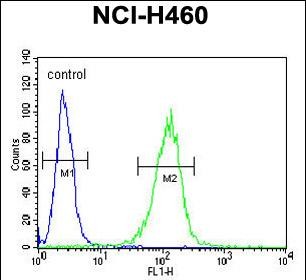COQ9 Antibody (Center)
Affinity Purified Rabbit Polyclonal Antibody (Pab)
- SPECIFICATION
- CITATIONS
- PROTOCOLS
- BACKGROUND

Application
| FC, IHC-P, WB, E |
|---|---|
| Primary Accession | O75208 |
| Other Accession | Q68FT1, Q8K1Z0 |
| Reactivity | Human, Mouse |
| Predicted | Rat |
| Host | Rabbit |
| Clonality | Polyclonal |
| Isotype | Rabbit IgG |
| Calculated MW | 35509 Da |
| Antigen Region | 156-184 aa |
| Gene ID | 57017 |
|---|---|
| Other Names | Ubiquinone biosynthesis protein COQ9, mitochondrial, COQ9, C16orf49 |
| Target/Specificity | This COQ9 antibody is generated from rabbits immunized with a KLH conjugated synthetic peptide between 156-184 amino acids from the Central region of human COQ9. |
| Dilution | FC~~1:10~50 IHC-P~~1:50~100 WB~~1:1000 E~~Use at an assay dependent concentration. |
| Format | Purified polyclonal antibody supplied in PBS with 0.09% (W/V) sodium azide. This antibody is purified through a protein A column, followed by peptide affinity purification. |
| Storage | Maintain refrigerated at 2-8°C for up to 2 weeks. For long term storage store at -20°C in small aliquots to prevent freeze-thaw cycles. |
| Precautions | COQ9 Antibody (Center) is for research use only and not for use in diagnostic or therapeutic procedures. |
| Name | COQ9 (HGNC:25302) |
|---|---|
| Synonyms | C16orf49 |
| Function | Membrane-associated protein that warps the membrane surface to access and bind aromatic isoprenes with high specificity, including ubiquinone (CoQ) isoprene intermediates and presents them directly to COQ7, therefore facilitating the COQ7-mediated hydroxylase step (PubMed:25339443, PubMed:30661980, PubMed:38425362). Participates in the biosynthesis of coenzyme Q, also named ubiquinone, an essential lipid-soluble electron transporter for aerobic cellular respiration (PubMed:25339443, PubMed:30661980). |
| Cellular Location | Mitochondrion {ECO:0000250|UniProtKB:Q8K1Z0}. Note=Associates with cardiolipin-rich membranes which leads to the lipid bilayer deformation and then accessing to membrane-bound lipids |

Thousands of laboratories across the world have published research that depended on the performance of antibodies from Abcepta to advance their research. Check out links to articles that cite our products in major peer-reviewed journals, organized by research category.
info@abcepta.com, and receive a free "I Love Antibodies" mug.
Provided below are standard protocols that you may find useful for product applications.
Background
Coenzyme Q10 (CoQ10), or ubiquinone, is a mobile lipophilic electron carrier critical for electron transfer by the mitochondrial inner membrane respiratory chain. COQ9 is 1 of several enzymes involved in biosynthesis of CoQ10 and likely functions in modification of the benzoquinone ring.
References
Duncan, A.J., et al. Am. J. Hum. Genet. 84(5):558-566(2009)
Loftus, B.J., et al. Genomics 60(3):295-308(1999)
If you have used an Abcepta product and would like to share how it has performed, please click on the "Submit Review" button and provide the requested information. Our staff will examine and post your review and contact you if needed.
If you have any additional inquiries please email technical services at tech@abcepta.com.













 Foundational characteristics of cancer include proliferation, angiogenesis, migration, evasion of apoptosis, and cellular immortality. Find key markers for these cellular processes and antibodies to detect them.
Foundational characteristics of cancer include proliferation, angiogenesis, migration, evasion of apoptosis, and cellular immortality. Find key markers for these cellular processes and antibodies to detect them. The SUMOplot™ Analysis Program predicts and scores sumoylation sites in your protein. SUMOylation is a post-translational modification involved in various cellular processes, such as nuclear-cytosolic transport, transcriptional regulation, apoptosis, protein stability, response to stress, and progression through the cell cycle.
The SUMOplot™ Analysis Program predicts and scores sumoylation sites in your protein. SUMOylation is a post-translational modification involved in various cellular processes, such as nuclear-cytosolic transport, transcriptional regulation, apoptosis, protein stability, response to stress, and progression through the cell cycle. The Autophagy Receptor Motif Plotter predicts and scores autophagy receptor binding sites in your protein. Identifying proteins connected to this pathway is critical to understanding the role of autophagy in physiological as well as pathological processes such as development, differentiation, neurodegenerative diseases, stress, infection, and cancer.
The Autophagy Receptor Motif Plotter predicts and scores autophagy receptor binding sites in your protein. Identifying proteins connected to this pathway is critical to understanding the role of autophagy in physiological as well as pathological processes such as development, differentiation, neurodegenerative diseases, stress, infection, and cancer.




